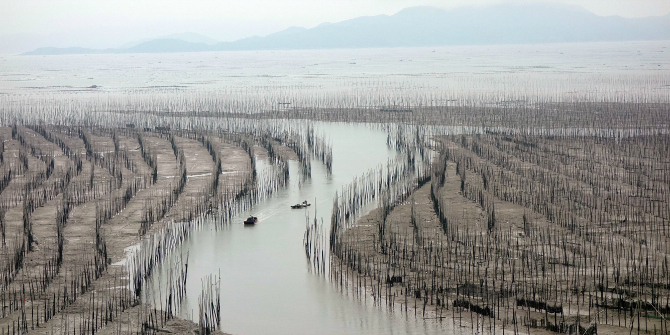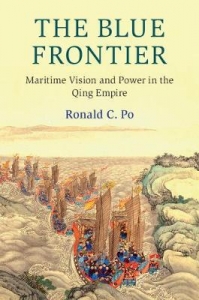In The Blue Frontier: Maritime Vision and Power in the Qing Empire, Ronald C. Po challenges the notion that the Qing dynasty neglected its oceanic boundaries, instead showing how it enacted comprehensive maritime policies across the long eighteenth century. The book’s project of historicising the production and projection of Chinese coastal territoriality is a valuable one, finds Tom Marling.
This book review has been translated into Mandarin by Martina Chow and Riccardo Cociani and proof-read by Fei Yuan (Mandarin LN808-2, teacher Fei Yuan) as part of the LSE Reviews in Translation project, a collaboration between LSE Language Centre and LSE Review of Books. Please scroll down to read this translation or click here.
The Blue Frontier: Maritime Vision and Power in the Qing Empire. Ronald C. Po. Cambridge University Press. 2018.
In the ‘great evacuation’ of 1661, China’s Qing Dynasty (1636-1912) effected a unilateral ban on the sea itself. Fearing an uprising originating in Taiwan and making land in south China, the teenage Kangxi Emperor forcibly relocated every person of the littoral populations of Guangdong, Fujian, Zhejiang, Jiangsu and Shandong provinces inland. The penalty for returning to the water was death. In what are today some of the most heavily populated tracts of land in the world – including the sites of modern-day Hong Kong, Shenzhen, Zhuhai and Xiamen – no civilian would set foot and no vessel would set out to sea.
The Blue Frontier: Maritime Vision and Power in the Qing Empire by Ronald Po presents a revisionist take on the traditional narrative of Qing maritime luddism, one which suggests that the great evacuation would best be understood as the final paroxysm of a worldview turning itself inside-out. Recalling Joseph Conrad’s disdainful depiction of French colonialism in Africa as constituted solely of ‘soldiers […] and customhouse clerks [… and] more soldiers to take care of the customhouse clerks’, Po finds that the Qing enacted a comprehensive maritime policy motivated by the kind of military-commercial alliance that is more commonly associated with the British instigation of the Opium Wars.
Chapter Three, ‘The Dragon Navy’, proposes that, unlike its Ming Dynasty counterpart commanded by the eunuch-adventurer Zheng He, the Qing navy hued closer to the modern role of a coastguard. Building on a lucid demonstration of the Qing state’s growing territorial assertiveness toward its oceanic boundaries, Po finds that the reconstructed navy was typically tasked with projecting its power within sight of the Chinese landmass, thereby transforming that narrow strip of commercially-viable ‘sea space’ into territory. Curiously bureaucratic as far as a war cry goes, the Qing naval slogan of ‘protect commerce and eliminate pirates’ indicates the extent to which, not unlike the contemporary war on drugs, military power was directed not against the forces of other nations, but against an unsanctioned (i.e. untaxed) commerce (piracy) that was undermining the smooth operations of sanctioned commerce.
 Image Credit: Fujian, China (yuen yan CC BY SA 2.0)
Image Credit: Fujian, China (yuen yan CC BY SA 2.0)
Some of the most interesting revelations in The Blue Frontier relate to previously unrecognised registers of regional and ethnic tensions in the Qing state. The initial impetus for the great evacuation had been the dubious loyalties of the southern Chinese populations toward the ethnically-other Manchus in power. By the following century, however, the Qing was forced to turn to this population to implement its maritime policy, in the process admitting that not only was it reliant on the southern seafaring economy for taxation income, but also upon that population’s extensive maritime knowledge to create and manage the navy to protect this economy.
Distrust of the southern Chinese remained endemic, however. The state routinely worried itself over the possibility that seafaring merchants would return from their sojourns in south-east Asia as enemy agents. This suspicion perhaps explains why enthusiasm for the project of developing a naval presence in the South China Sea waxed and waned. It was also not unjustified. The ‘dragon navy’ was constructed to protect the region’s merchants from piracy, merchants who, as it turned out, were also the region’s pirates in fallow times. Pirates would typically surrender bloodlessly, and would in turn frequently be recruited into the navy. Far from the northern seat of power, the state found that it was in effect paying to end piracy as much as eradicate it. The situation was similarly problematic when it came to the southern control over customs. The southern city of Canton (better known today as Guangzhou), which handled the vast majority of trade with Western nations, faced chronic problems with corruption, even as local officials strenuously argued against any diminution of its monopoly.
As a historian, Po is little prone to speculation, and his account, though fastidious, culminates inconclusively. Qing maritime policy vacillated frequently, and Po is ultimately only able to state, somewhat weakly, that ‘the Qing did not ignore its maritime frontier’. Absent a more definitive resolution, The Blue Frontier turns to identifying a deeper current of ‘maritime consciousness’ beneath the erratic swells and troughs of maritime policy. Like the recourse to the theory of ‘the production of space’ in the book’s opening chapter, consciousness fits awkwardly with Po’s tendencies as a historian. This is no more evident than in the final chapter, ‘Writing the Waves’, which deals with the works of three eighteenth-century authors. While the move away from practical officialdom and toward literary conceptualisation should present an opportunity for greater engagement with social history, discussion rarely strays from semantics, and seems far from touching on something as lofty as collective consciousness. Readers interested in other attempts at this consciousness-led approach might consider turning to China on the Sea: How the Maritime World Shaped Modern China (Brill, 2011) by Zheng Yangwen (also author of the excellent The Social Life of Opium in China).
Nonetheless, coming at a time in which Chinese and American ships are drawing close to collision in the South China Sea, Po’s overall project of historicising the production and projection of Chinese coastal territoriality is a valuable one. Thought-provoking presentiments of contemporary maritime policy abound in Po’s account, not least of which being the Qing’s apparent predilection for ‘annexing offshore islands, shoals and sandbars’.
Although it was Emperor Kangxi who inaugurated the high Qing, the era is most closely associated with the 60-year reign of his nephew, Qianlong. The comparison between Qianlong and Xi Jinping has been made before, and The Blue Frontier offers plenty of grist to the mill. Both found themselves mired in a bilateral borderland quagmire, simultaneously managing restive populations to the western extents of China and asserting authority along the oceanic frontiers to the east. Like Xi, Qianlong inherited the fruits of his predecessors’ opening to the outside world, and was tasked with the delicate task of projecting this newfound wealth as power. Whether Xi’s reign, like Qianlong’s, will eventually be viewed as little more than a ‘glorious façade’ looks set to hinge in part on projects like the Belt and Road Initiative succeeding where Qianlong could not – in creating a China that dictates relations with the outside world, rather than reacting to them.
Tom Marling has a PhD in History from Hong Kong Baptist University. His research interests include late-Qing tabloid fiction and the urban environment of Shanghai, and the history of pre-CCP organised labour in south China. He is one of the co-editors of Collected Essays of To the Seas and Beyond: An International Conference on the Maritime Silk Road (Hong Kong Museum of History and Hong Kong Baptist University Department of History, 2018).
Note: This review gives the views of the author, and not the position of the LSE Review of Books blog, or of the London School of Economics.
《蓝色边疆:清朝帝国的海洋愿景与权力》,布琮任,剑桥大学出版社,2018。
Review translated by Martina Chow and Riccardo Cociani and proof-read by Fei Yuan (Mandarin LN808-2, teacher Fei Yuan)
 在《蓝色边疆:清朝帝国的海洋愿景与权力》中,布琮任质疑满清忽略自己的海域国界,而是展示了它如何制定了十八世纪的综合海洋政策。汤姆·马林说,这本书是关于中国沿海地域生产和投影历史化,整个项目对他来说非常宝贵。
在《蓝色边疆:清朝帝国的海洋愿景与权力》中,布琮任质疑满清忽略自己的海域国界,而是展示了它如何制定了十八世纪的综合海洋政策。汤姆·马林说,这本书是关于中国沿海地域生产和投影历史化,整个项目对他来说非常宝贵。
如果你对这本书感兴趣,这本书已于2018年11月22日在伦敦政治经济学院发布。更多的资料可以在这里找到。
在1661年的“大撤离”中,中国的清朝(1636-1912)实行了单方面的海洋禁令。因为他害怕台湾和华南地区的,康熙皇帝把广东、福建、浙江、江苏和山东的人口强制迁移到内地,返回海岸的惩罚是死刑。在今天的世界上一些人口最稠密的土地 – 包括现代香港、深圳、珠海和厦门,没有平民可以涉足,也没有船只会出海。
布琮任的《蓝色边疆:清朝帝国的海洋愿景与权力》介绍了一个修正主义者关于满清海域的哲学故事,这表明“大撤退”最好被理解为世界观的最终爆发。回顾约瑟夫·康拉德对非洲法国殖民主义的蔑视描述完全由“士兵和海关职员[以及]更多士兵来照顾海关职员”构成,他发现清朝制定了一项全面的海上政策,其动机是这种军事商业联盟更常见于英国对鸦片战争的煽动。
第三章“龙海军”提出,与宦官冒险家郑和指挥的明代不同,满清的海军更像现代海岸警卫队。因为满清对自己的海域国界越来越强的斗争性论证,在清楚地证明清朝对其海洋边界日益增强的领土主张的基础上,布琮任发现重建的海军通常负责将其力量投射到中国陆地的视线范围内,从而改变了商业上可行的“海洋空间”的狭窄区域。进入领土。满清的海军标语 “保护商业、消除海盗”是非常官僚的。但是,与现代的毒品战争不同,军事力量不是针对其他国家的力量,而是针对未经批准(即免税)的商业(盗版)正在破坏受制裁商业的顺利运作。
 Image Credit: Fujian, China (yuen yan CC BY SA 2.0)
Image Credit: Fujian, China (yuen yan CC BY SA 2.0)
“蓝色边疆”中一些最有趣的启示与以前未被承认的清朝地区和种族紧张局势的记录有关。大规模撤离的最初动力是中国南方人口对其他当地满族的忠诚。但是,到了下个世纪,为了实施海洋,在这个过程中承认,它不仅依赖于南方航海经济的税收收入,而且还依赖于该人口广泛的海洋知识。创建和管理海军以保护这一经济。
但是,对于中国南方人的不信任仍然流行着。政府经常担心航海商人可能会从他们在东南亚的栖息地返回,成为敌方的特工。这个怀疑也许说明了为什么对在南海发展军舰据点项目的热情下降了。这也不是没有道理的。 为了对抗海盗行为,为了保护地区的商人免受海盗的伤害,“龙海军”成立了,原来商人休耕时期中也会成为海盗。海盗通常不流血地屈服,还陆续被应征加入海军。在远离北方权力的情况下,政府发现它实际上是为了结束海盗花钱,而不是根除它。当南方海关控制的情况同样此存在麻烦时,南边的坎墩(今天称为“广州”),其实处理者跟西方国家的大多数贸易,面临着腐败的顽固问题,即使地区官员极力反对任何垄断的减少。
作为历史学家,布琮任很少去推测事情,他的记载经常没有结论,虽然他的记载很苛刻。 清朝海事政策经常动摇,布琮任教授最终只能不太确定地说:“清朝没有忽略他们的海洋边境”。在没有更明确的解决方案的情况下,蓝色边疆转向在海洋政策的不稳定的膨胀和低谷之下找到更深层次的“海洋意识”。就像在第一章里的“空间的生产”理论一样,意识与布琮任作为历史学家的倾向尴尬地吻合。这一点并不比最后一章“在浪潮里写作”更明显,该章论述了三位十八世纪作家的作品。虽然从落实官场到文学的概念化应该介绍跟社会历史碰撞的机会,讨论很少离题,并且似乎远没有触及像集体意识那样崇高的东西。对这种以意识为主导的方法的其他尝试感兴趣的读者可能会考虑转向中国海上:海洋世界如何塑造现代中国(Brill,2011),郑阳文(也是《中国优秀的鸦片社会生活》的作者)。
虽然如此,在中国和美国船只在中国南海碰撞的时期,布琮任的中国沿海地域生产和投影历史化的整体是一个很价值的项目。布琮任的记载充满了现代海事政策的发人深省的思考,尤其是清朝明显偏爱“吞并近海岛屿、浅滩和沙洲”。
虽然是康熙皇帝开辟了清朝的辉煌,但这个时代与他的侄子乾隆60年的统治密切相关。乾隆与习近平的比较很多,《蓝色边疆》一书提供了很多支持。他们俩都发现自己陷入了双边边境泥潭,同时在中国西边管理动荡的人口,并在中国东边的海边宣称自己的权力。与习近平一样,乾隆继承了他的前任向世界开放的果实,肩负着将这一新发现的财富作为权力投射出来的微妙任务。习近平的朝代跟乾隆的一样被将终究被看作“光荣的外观” 看起来将部分取决于乾隆无法成功的“一带一路”项目——创建一个决定与外界关系的中国世界,而不是对他们作出反应。
汤姆·马林是香港浸会大学历史博士。他的研究兴趣包括晚清朝小报小说和上海的市区环境,以及在中国南边前中国共产党的劳动历史。《海上丝绸之路国际会议》(香港历史博物馆和香港浸会大学历史系,2018年)的共同编辑之一。


 Find this book:
Find this book: 



